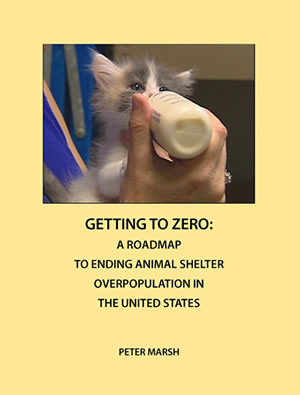|
 INTRODUCTION INTRODUCTION
By the early 1990s, American animal shelters had been struggling against overpopulation for more than a century. Those working in shelters believed they understood what caused it and how best to handle it. They thought shelters should be the first line of defense against it and that it would be inhumane if they refused to immediately admit every animal a person wanted to give up. They worried that if they told other people what this meant—how many animals had to be put to death— many would turn against them. It seemed to them that no one else cared about homeless animals or what happened to them. Just them.
Twenty years ago, some began to take a second look at these commonly-held beliefs. This book tells about the journey they took and what they discovered. It tells about:
- The conventional wisdom they found to be mistaken, shown in ten highlighted sections or sidebars throughout the book;
- The lessons they learned, as shown in two dozen Lesson Sidebars, and how these lessons can be applied to develop more effective shelter overpopulation programs;
- The programs that will be needed to end overpopulation throughout the country and the principles that underlie them, shown in fourteen Getting to Zero sidebars;
- The new humane ethic that has emerged and the work that will remain after shelters no longer put animals to death just to make room for more homeless animals.
As is fitting for a book about companion animals, this book has a companion, an earlier book called Replacing Myth With Math: Using Evidence-Based Programs to Eradicate Shelter Overpopulation. There are references throughout this book to data and other information contained in the earlier work, for those who would like to dig a little deeper.
Included with this book is another companion, a documentary film by Bill Millios, A Community Comes Together to Save Its Companion Animals: The New Hampshire Story. Bill made this film to update an extraordinary film he made in 1994 about New Hampshire animal shelters, Killing Our Best Friends. People working in shelters throughout the state made great progress in their lifesaving work since the first film was made. Bill made A Community Comes Together in an attempt via GETTING TO ZERO: A ROADMAP TO ENDING ANIMAL SHELTER OVERPOPULATION IN THE UNITED STATES to better understand how that happened. He hopes understanding what happened here will be of some value to animal protection groups working in other parts of the country where the rate at which homeless animals are put to death in shelters is now as high or higher than it was here in the early 1990s, before things turned around.
He has kindly allowed me to provide copies of his film with this book. It is a very welcome addition. It allows many of the people who were the most responsible for the great strides shelters made to tell what happened. Like the book, the film tells their story, how they worked tirelessly to bring together everyone who cared about the homeless animals in our state, how they changed their world—and the lives of the companion animals they cared for—by changing the way they looked at the world.
Many thanks to Barbara Carr, Gregory Castle, Rick DuCharme, Frank Hamilton, Jim Mason, Sue MacRae, Bill Millios, Bert Troughton, and Esther Mechler for their generosity in reviewing parts of the manuscript. Special thanks to Rick Hall for the thoughtful and valuable suggestions he made about how to improve the book, to Donna Maurer for the care and precision with which she edited the manuscript, and to Bunny Stoykovich for the patience and good humor with which she put this book together. And, most of all, to Roxanne.
Concord, New Hampshire
September, 2012
|
|
|